Nicole Wermers’ Day Care: disrupting smoothness at The Common Guild
At The Common Guild’s temporary space in a Glasgow office block, German
artist Nicole Wermers presents a series of sculptures of women’s bodies at work
& rest. Set within the shiny, polished office space with a backdrop of
Glasgow’s urban roofscape, Jonathan McAloon considers whether the works disrupt
& interrogate, or add to the seamless smooth continuum of modern life.
In a 2022 Zoom interview with the Kunsthaus Glarus director
Melanie Ohnemus, Nicole Wermers described her sculptures as informed by “rituals”
of public space and the “relationships between people and space.” They can
take the form of bikes welded to their racks or column-like minimalist works
with an ashtray on top that convince as assemblages, but also, perhaps, as
design objects in their own right: functional ashtrays for an aesthetically
committed smoker. In 2015’s Turner Prize-nominated show Infrastruktur,
fur coats hung off the back of modernist chairs, appearing as if an absent
sitter had modified the environment by claiming them. But the German-born,
London-based artist had re-lined the coats with silk to match the chair
leather, then sewed them together.
As far as relationships between people and a space go, there are few as intimate as that which exists between a space and the person who cleans it every day. Few actions more physically engaged with a public space than its constant upkeep. Wermer’s show Day Care, at The Common Guild in Glasgow, is perhaps the fullest expression of a theme that has occupied her for around a decade.
![]()
The gallery-goer takes a lift to the seventh floor of the Capella Building, an eleven-story rotunda in Glasgow’s business district which is mainly office space. The Common Guild’s premises snake round the building’s curved façade. Floor to ceiling plate-glass windows provide a view of the city, as well as ample light for five lounging figures mounted on maintenance trolleys. Executed in plaster over Styrofoam, these large sculptures of nude women have the rough, frank porousness of stone. Being at eye-level, they require you to inspect them directly, and you get the sense that the figures are witnessing you inspect them. They represent the maintenance workers who use the products gathered below – industrial sized jerrycans of floor cleaner, polish, white spirit, and air freshener – to keep hotels, office buildings (like this one) and galleries (like this one) in a state we take for granted.
Wermers refers to this series of sculptures as her Reclining Females (2022-2024). They play on the tradition of the reclining nude, from the Sleeping Venus, the Venus of Urbino, and the Rokeby Venus onwards – you get the picture – in which a model might be depicted in leisured stasis, belying the hours of athletic work that would have gone into maintaining a pose. Not to mention the other physically arduous side-hustles which the sitter may have been obliged to perform alongside her modelling, such as sex work.
![]()
![]()
Like the fur coats for the back of her Untitled Chairs series in Infrastruktur, Wermers sourced the utility carts on eBay. There’s a sense of striving for verisimilitude about the trolly arrangements, which contain boxes of mini shower gels, paper towels in bulk still in their plastic wrap, J Cloths, and bags for life. There are crumpled bed sheets and folded fresh ones. Plump towels, neatly stacked. Pendulous bin liners. A plastic bag carries the insignia of a four-star hotel in Verona, but it is filled to brim, twisted to the side functionally. This is not a fresh bag used by a customer, conveying the hotel’s brand through the streets – this is a bag used because it was to hand, crammed with things rather than containing things.
A makeshift feel continues right up the plinths. Wermers has left clumps of plaster everywhere. Which is to say, all the culture before you is propped up by work. A lot of raw materials, and then a lot of unglamorous, difficult, and often invisible labour goes into the creation of the art works, then the maintenance of gallery spaces, then the maintenance of wider corporate entities or structures which either house these gallery spaces or just keep their lights on.
The whole ecosystem, then, comes down to this. As you look at the cleaning products, your field of vision may also be shared by the space’s aluminium floor tiles. These could conceivably have been made to gleam by the application of a similar substance only hours earlier. Some of these floor tiles have been removed for a work called Break (2024), the space filled with sand and spent cigarette butts, black ash mixing with the sand’s more general beige. Wermers was inspired to do this in situ, seeing office workers below have a cigarette break from the windows as she installed the show. Perhaps her reclining females have stepped down from posing arduously on their plinths and taken a breather.
![]()
![]()
figs.iv,v
The shiny floors. The curve of the room. The spectacular horizon, which, it should be said, seems almost dutifully layered and textured – as well as a view of the city, we also see the roof of a neighbouring building which wasn’t made to be gazed on, with its tanks, vents, and brown pools of rainwater, allowing us to catch its often hidden topside, similar to how the show itself allows us to see culture’s often-hidden underside.
At times, however, this immersive seamlessness of the experience isn’t to the work’s credit. At times, Day Care felt less an exhibition that engages exceptionally well with a corporate space, than an exhibition designed for a corporate space: privately commissioned semi-public art that we might see in the courtyards or lobbies of new luxury apartments, pitched to enhance the value and aura of a commercial venture or entity, rather than passing comment on it.
Wermers has acknowledged the interwoven nature of corporate capital and art. Most would be lying if they said they weren’t happy to see the one funnelled into the other – think of gleaming Sarah Lucas marrows sprouting up outside Nine Elms new-builds, or Random International’s installations along the Thames – if the alternative is it being funnelled away elsewhere. The art world is one of the few spaces where trickle-down economics can be argued to actually happen.
But within The Common Guild’s premises, there was a gloss to the effect of these works which, I felt sure, couldn’t have been entirely legislated by Wermers’ initial intention. Indeed, in a recent Art Monthly interview she spoke against the optimised “smoothness” of modern life: of progress’s need to leave no gaps between one experience and another; of surfaces designed so they are easier to clean; of buildings constructed to match the renderings on an architect’s computer demo.
![]()
![]()
The setting of Day Care, though, provides just such a seamless continuum for works whose tendency is supposed to be interrogatory, if not accusatory. The sculptures appeared – at least on the sunny day I attended – polished to a high shine by the flawless, expanding afternoon horizon from all sides. It was as if the products beneath them had been applied to the stippled surfaces of the figures perched above.
This isn’t unpleasant. It’s aesthetically lovely. But the effect is one of wholesome alchemy – unglamorous figures being afforded a glamour not usually open to them – rather than argument and provocation. And I couldn’t help but feel they were made resplendent in a way that contradicts the case made by the gallery material: that these figures are exhausted by their low-wage labour. And despite the evidence of spent or spare artistic materials around them – the smudges and clumps of grey plaster – the Reclining Females appear, through their situation, divested of the work that it has taken to produce them. It’s made to look easy. It’s not made to look hard.
I expect a different space, or different relationship with a space, might have fostered a different attitude. But the seamlessness of the corporate interplay which The Common Guild premises allow Wermers did afford one last triumph, and something another space wouldn’t offer.
On my way out, back down in the elevator, I couldn’t help but think of other elevators. Of those moments in the mid-morning, when hotel guests might briefly overlap with housekeeping staff in the middle of a quick changeover. When the person who has left the room, on their way to check out, will encounter the person who will clean the room, sharing a lift ride with them and the maintenance trolley they use.
![]()
![]()
As far as relationships between people and a space go, there are few as intimate as that which exists between a space and the person who cleans it every day. Few actions more physically engaged with a public space than its constant upkeep. Wermer’s show Day Care, at The Common Guild in Glasgow, is perhaps the fullest expression of a theme that has occupied her for around a decade.

fig.i
The gallery-goer takes a lift to the seventh floor of the Capella Building, an eleven-story rotunda in Glasgow’s business district which is mainly office space. The Common Guild’s premises snake round the building’s curved façade. Floor to ceiling plate-glass windows provide a view of the city, as well as ample light for five lounging figures mounted on maintenance trolleys. Executed in plaster over Styrofoam, these large sculptures of nude women have the rough, frank porousness of stone. Being at eye-level, they require you to inspect them directly, and you get the sense that the figures are witnessing you inspect them. They represent the maintenance workers who use the products gathered below – industrial sized jerrycans of floor cleaner, polish, white spirit, and air freshener – to keep hotels, office buildings (like this one) and galleries (like this one) in a state we take for granted.
Wermers refers to this series of sculptures as her Reclining Females (2022-2024). They play on the tradition of the reclining nude, from the Sleeping Venus, the Venus of Urbino, and the Rokeby Venus onwards – you get the picture – in which a model might be depicted in leisured stasis, belying the hours of athletic work that would have gone into maintaining a pose. Not to mention the other physically arduous side-hustles which the sitter may have been obliged to perform alongside her modelling, such as sex work.
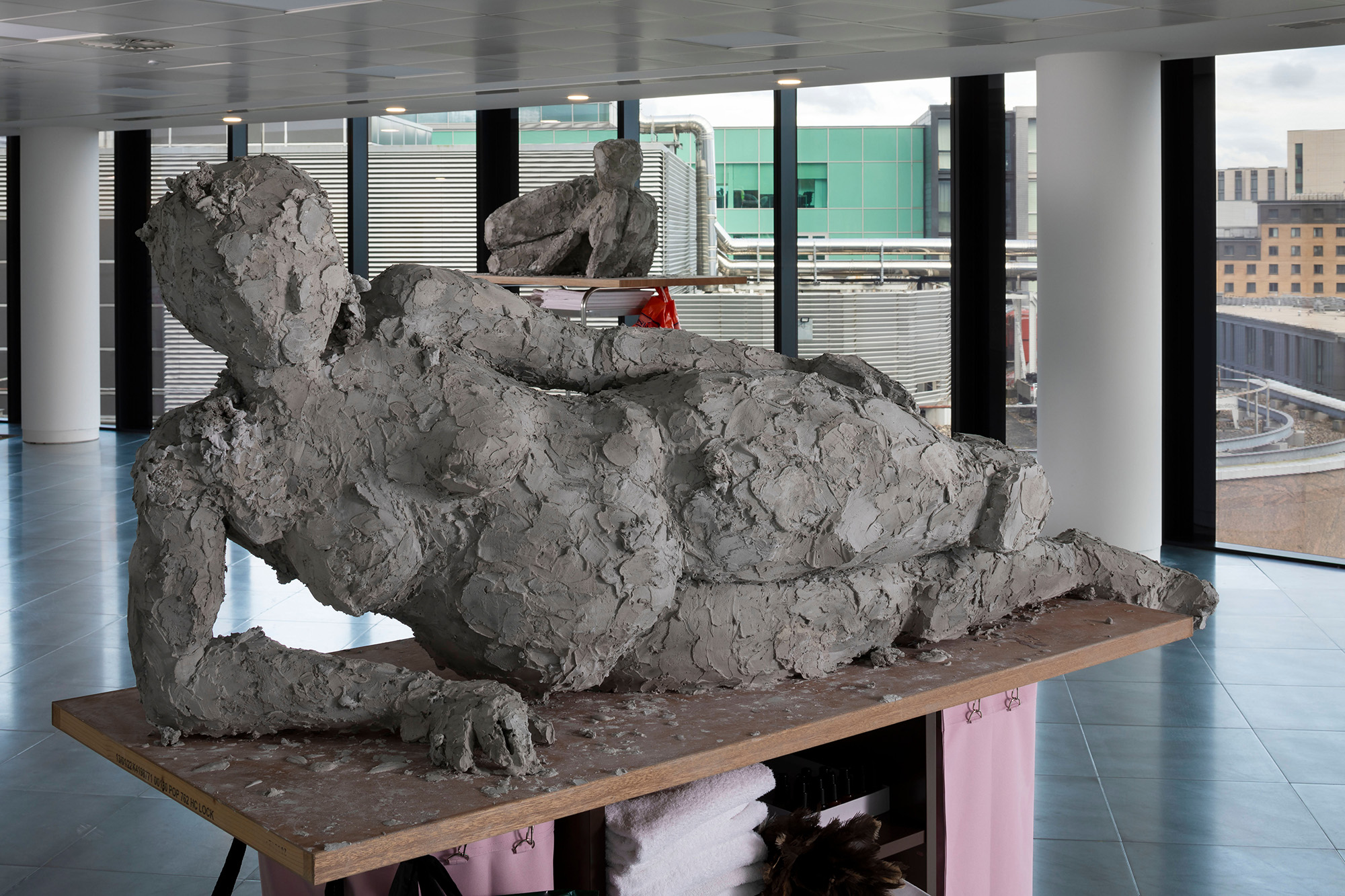
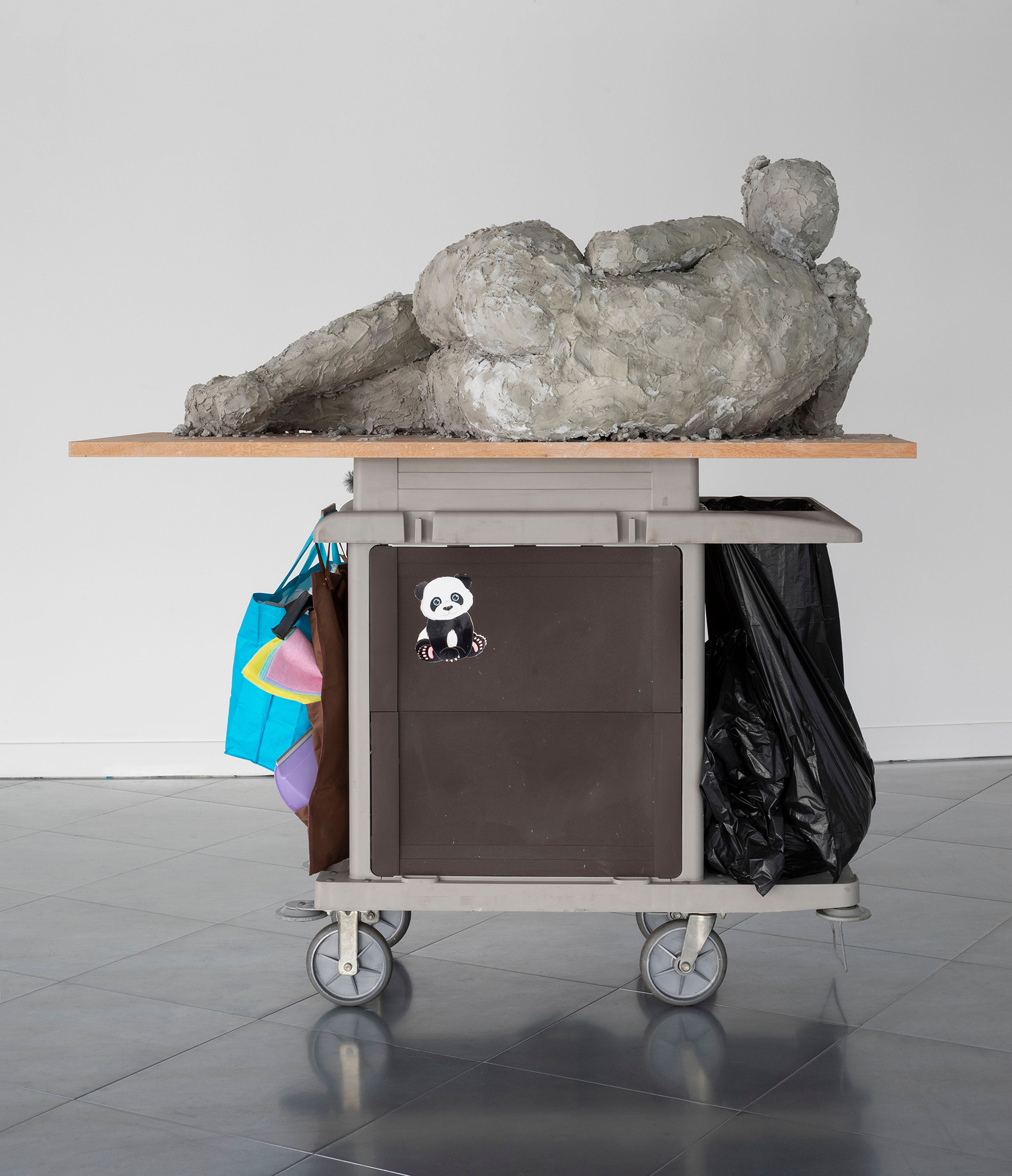
figs.ii,iii
Like the fur coats for the back of her Untitled Chairs series in Infrastruktur, Wermers sourced the utility carts on eBay. There’s a sense of striving for verisimilitude about the trolly arrangements, which contain boxes of mini shower gels, paper towels in bulk still in their plastic wrap, J Cloths, and bags for life. There are crumpled bed sheets and folded fresh ones. Plump towels, neatly stacked. Pendulous bin liners. A plastic bag carries the insignia of a four-star hotel in Verona, but it is filled to brim, twisted to the side functionally. This is not a fresh bag used by a customer, conveying the hotel’s brand through the streets – this is a bag used because it was to hand, crammed with things rather than containing things.
A makeshift feel continues right up the plinths. Wermers has left clumps of plaster everywhere. Which is to say, all the culture before you is propped up by work. A lot of raw materials, and then a lot of unglamorous, difficult, and often invisible labour goes into the creation of the art works, then the maintenance of gallery spaces, then the maintenance of wider corporate entities or structures which either house these gallery spaces or just keep their lights on.
The whole ecosystem, then, comes down to this. As you look at the cleaning products, your field of vision may also be shared by the space’s aluminium floor tiles. These could conceivably have been made to gleam by the application of a similar substance only hours earlier. Some of these floor tiles have been removed for a work called Break (2024), the space filled with sand and spent cigarette butts, black ash mixing with the sand’s more general beige. Wermers was inspired to do this in situ, seeing office workers below have a cigarette break from the windows as she installed the show. Perhaps her reclining females have stepped down from posing arduously on their plinths and taken a breather.


figs.iv,v
The shiny floors. The curve of the room. The spectacular horizon, which, it should be said, seems almost dutifully layered and textured – as well as a view of the city, we also see the roof of a neighbouring building which wasn’t made to be gazed on, with its tanks, vents, and brown pools of rainwater, allowing us to catch its often hidden topside, similar to how the show itself allows us to see culture’s often-hidden underside.
At times, however, this immersive seamlessness of the experience isn’t to the work’s credit. At times, Day Care felt less an exhibition that engages exceptionally well with a corporate space, than an exhibition designed for a corporate space: privately commissioned semi-public art that we might see in the courtyards or lobbies of new luxury apartments, pitched to enhance the value and aura of a commercial venture or entity, rather than passing comment on it.
Wermers has acknowledged the interwoven nature of corporate capital and art. Most would be lying if they said they weren’t happy to see the one funnelled into the other – think of gleaming Sarah Lucas marrows sprouting up outside Nine Elms new-builds, or Random International’s installations along the Thames – if the alternative is it being funnelled away elsewhere. The art world is one of the few spaces where trickle-down economics can be argued to actually happen.
But within The Common Guild’s premises, there was a gloss to the effect of these works which, I felt sure, couldn’t have been entirely legislated by Wermers’ initial intention. Indeed, in a recent Art Monthly interview she spoke against the optimised “smoothness” of modern life: of progress’s need to leave no gaps between one experience and another; of surfaces designed so they are easier to clean; of buildings constructed to match the renderings on an architect’s computer demo.
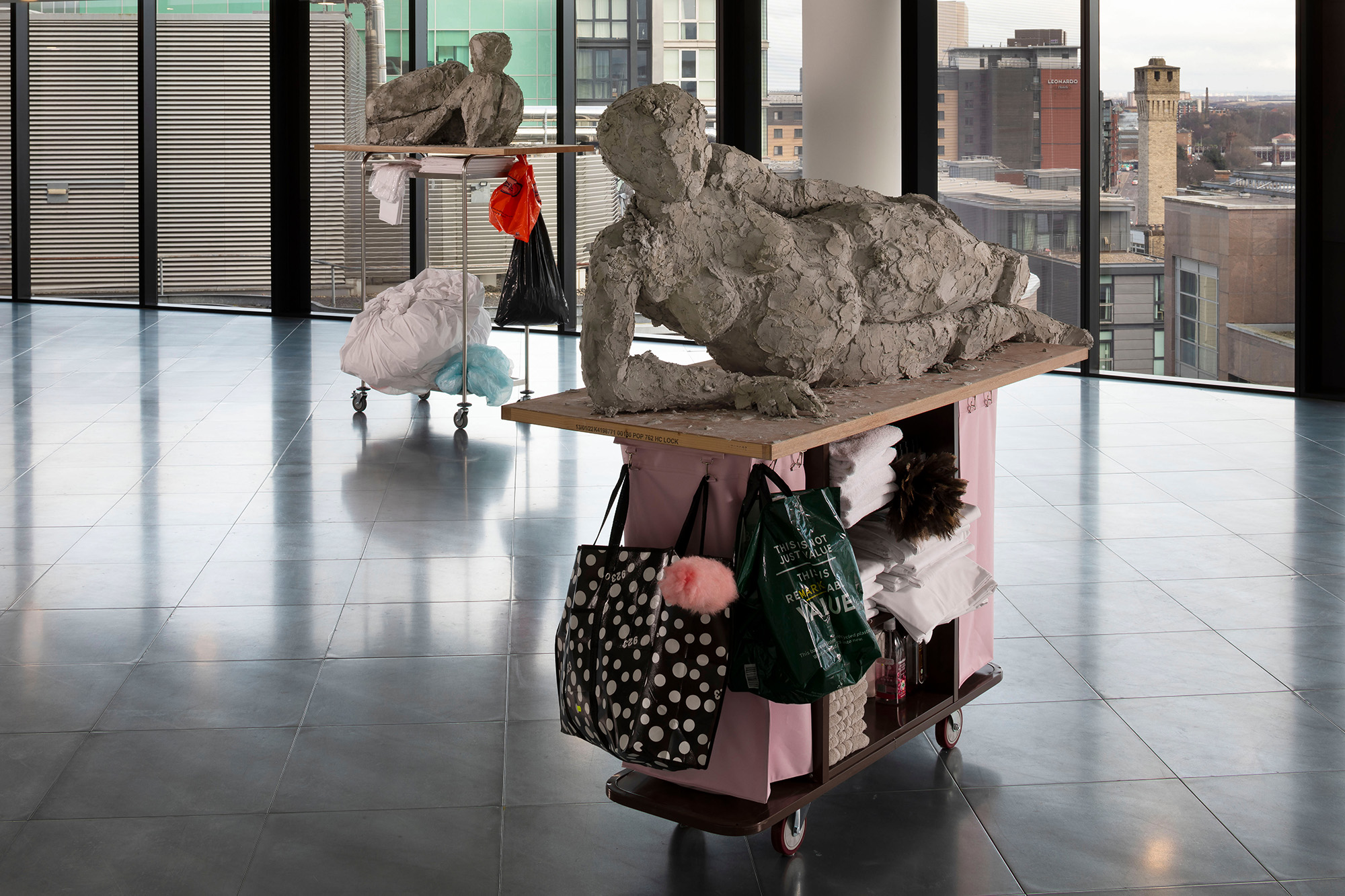

figs.vi,vii
The setting of Day Care, though, provides just such a seamless continuum for works whose tendency is supposed to be interrogatory, if not accusatory. The sculptures appeared – at least on the sunny day I attended – polished to a high shine by the flawless, expanding afternoon horizon from all sides. It was as if the products beneath them had been applied to the stippled surfaces of the figures perched above.
This isn’t unpleasant. It’s aesthetically lovely. But the effect is one of wholesome alchemy – unglamorous figures being afforded a glamour not usually open to them – rather than argument and provocation. And I couldn’t help but feel they were made resplendent in a way that contradicts the case made by the gallery material: that these figures are exhausted by their low-wage labour. And despite the evidence of spent or spare artistic materials around them – the smudges and clumps of grey plaster – the Reclining Females appear, through their situation, divested of the work that it has taken to produce them. It’s made to look easy. It’s not made to look hard.
I expect a different space, or different relationship with a space, might have fostered a different attitude. But the seamlessness of the corporate interplay which The Common Guild premises allow Wermers did afford one last triumph, and something another space wouldn’t offer.
On my way out, back down in the elevator, I couldn’t help but think of other elevators. Of those moments in the mid-morning, when hotel guests might briefly overlap with housekeeping staff in the middle of a quick changeover. When the person who has left the room, on their way to check out, will encounter the person who will clean the room, sharing a lift ride with them and the maintenance trolley they use.
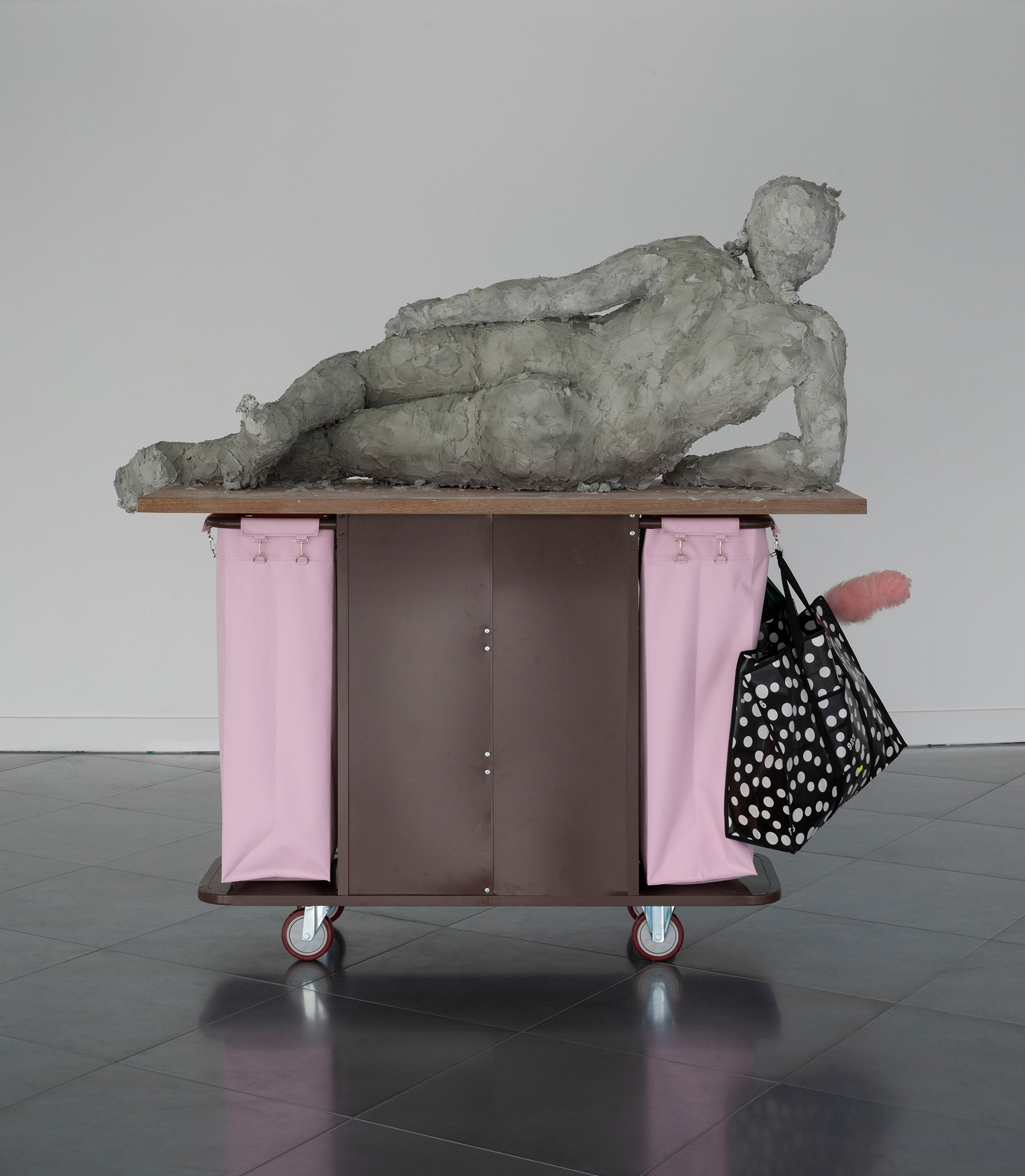
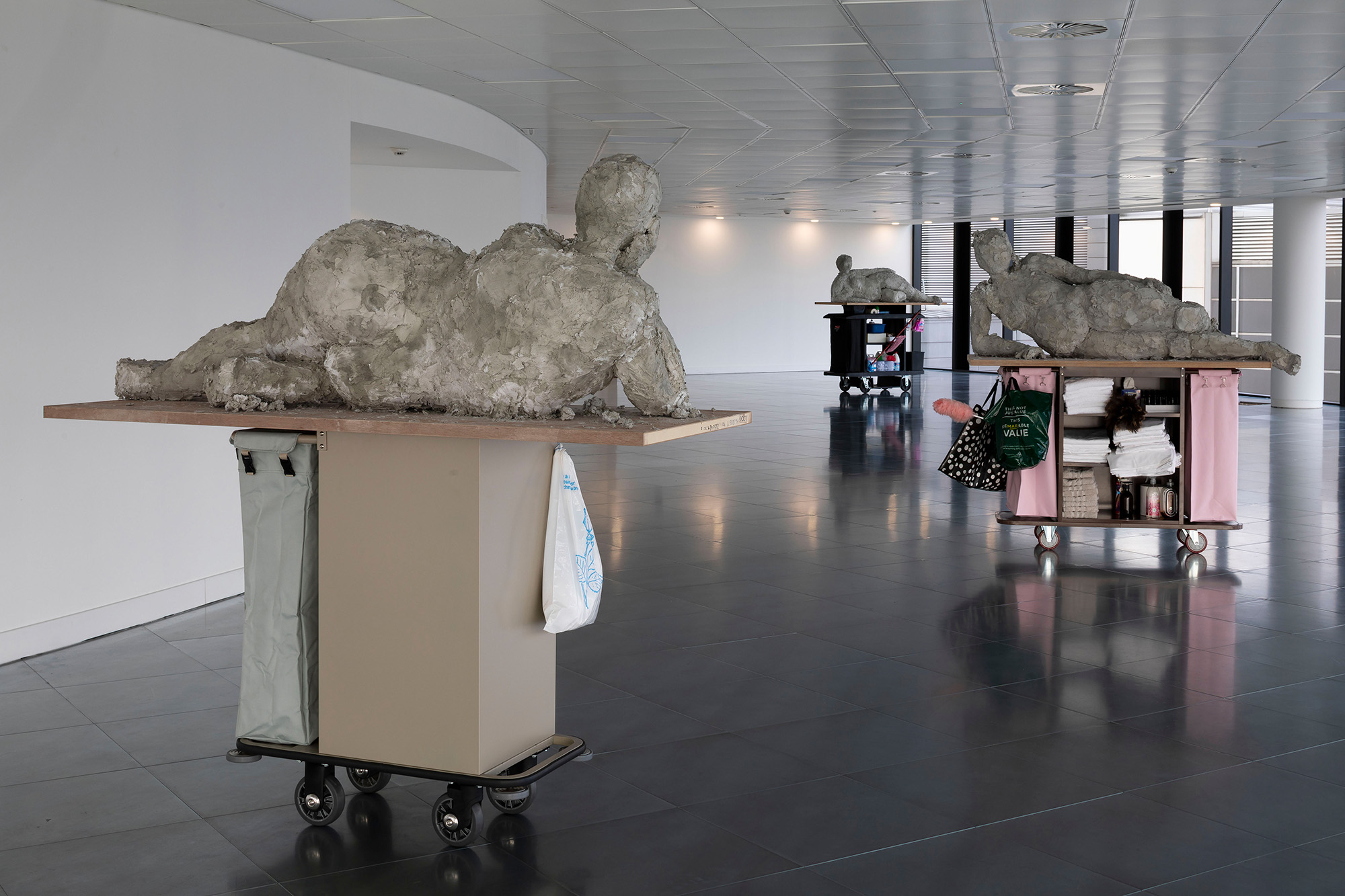
figs.viii,ix
Nicole Wermers (born 1971 in Emsdetten, Germany) lives and works in London. She studied at
Hochschule für bildende Künste, Hamburg from 1991–97 and received an MFA from Central Saint
Martins College of Art and Design in 1999. Since 2017 she has been a professor of sculpture at
Akademie der Bildenden Künste, Munich. Wermers was short-listed for the Turner Prize in 2015.
Selected solo exhibitions include: ‘Reclining Fanmail’, Kunsthaus Glarus; ‘P4aM2aRF!’, Herald St,
London; ‘Emscher Folly’, Urbane Künste Ruhr/ Emscher Kunstweg, Duisburg permanent public art
commission, (all 2022); ‘Earring for Cambridge’ public commission for Cambridge Judge Business
School, Cambridge University; ‘Women between Buildings’, Kunstverein Hamburg, (both 2018);
‘Grundstück’, Jessica Silverman Gallery, San Francisco, (2017); ‘Givers & Takers’ Tanya Bonakdar
Gallery, New York (2016); ‘Infrastruktur’, Herald St, London (2015); ‘The London Shape’ Stanley Picker Gallery, Kingston-upon-Thames (2014); ‘Manners’, site-specific commission for Tate Britain
(2013). ‘Hotel Biron‘, Kunstverein für die Rheinlande und Westfalen, Düsseldorf; ’Masse und
Auflösung’, Aspen Art Museum, Colorado (2007), ‘Earring‘ public sculpture project, Camden Arts
Centre, London; and ’Chemie’, Secession, Vienna (2004-2005).
Selected group exhibitions include: ‘13 Women: Variation III’, Orange County Museum of Art, Costa
Mesa, California; ‘Phantom Sculpture’, Mead Gallery, Warwick Arts Centre, Coventry; ‘Your Home Is
Where You’re Happy’, Haus Mödrath, Kerpen; ‘Homo Ludens / About the Game of Art’, Woods Art
Institute, Hamburg; ‘ Concerning Nature‘, Tanya Bonakdar Gallery, New York; ‘Femmenology‘, Jessica
Silverman Gallery, San Francisco (all 2023). ‘Identität nicht nachgewiesen – Neuerwerbungen derSammlung des Bundes’, Bundeskunsthalle Bonn; ‘SSSSSSSSSCULPTURESQUE’, Kiang Malingue
Gallery, Hong Kong; ‘German Caviar’, Kunstmuseum Bonn; ‘On Equal Terms’, Uferhallen, Berlin; ‘By
A Thread’, Tenter Ground, London (all 2022).
The Common Guild is a visual arts organisation based in Glasgow, with a varied public programme of
exhibitions, projects and events that take place in different locations. We are committed to presentingartists’ work in interesting and engaging ways and aim to create world-class contemporary art
experiences and discussions. The Common Guild is a not-for-profit organisation and charity registered
in Scotland, receiving Regular Funding from Creative Scotland.
The Common Guild’s current temporary space is in Glasgow city centre at 60 York Street (also known
as the Capella Builidng at Atlantic Quay). Situated on the seventh floor, the space has an expansive
view overlooking the River Clyde and beyond. The space is fully accessible with lift access to the
seventh floor.
www.thecommonguild.org.uk
Jonathan McAloon is an arts journalist and book critic. He has written for the FT, BBC, Guardian, Irish Times, Telegraph, Elephant and i-D, among others.
The Common Guild’s current temporary space is in Glasgow city centre at 60 York Street (also known as the Capella Builidng at Atlantic Quay). Situated on the seventh floor, the space has an expansive view overlooking the River Clyde and beyond. The space is fully accessible with lift access to the seventh floor.
www.thecommonguild.org.uk
Jonathan McAloon is an arts journalist and book critic. He has written for the FT, BBC, Guardian, Irish Times, Telegraph, Elephant and i-D, among others.
visit
Day Care by Nicole Wermers is on at The Common Guild, Glasgow, until 20 April. Further details at:
www.thecommonguild.org.uk/programme/nicole-wermers-day-care
images
figs.i,ii,vi,ix Nicole Wermers, ‘Day Care’ (2024). Installation view, The Common Guild at 60 York Street,
Glasgow. Courtesy the artist; Herald St, London; Tanya Bonakdar Gallery, New York and Los Angeles; Jessica Silverman, San Francisco; and Produzentengalerie Hamburg. Photo: Ruth Clark.
fig.iii Nicole Wermers, Reclining Female #6 (2024). Courtesy the artist; Herald St, London; Tanya
Bonakdar Gallery, New York and Los Angeles; Jessica Silverman, San Francisco; and Produzentengalerie Hamburg. Photo: Ruth Clark.
figs.iv,viii Nicole Wermers, Reclining Female #7 (2024). Courtesy the artist; Herald St, London; Tanya
Bonakdar Gallery, New York and Los Angeles; Jessica Silverman, San Francisco; and Produzentengalerie Hamburg. Photo: Ruth Clark.
fig.v Nicole Wermers, ‘Break’ (2024). Installation view, ‘Day Care’, The Common Guild at 60 York Street,
Glasgow. Courtesy the artist; Herald St, London; Tanya Bonakdar Gallery, New York and Los Angeles; Jessica Silverman, San Francisco; and Produzentengalerie Hamburg. Photo: Ruth Clark.
fig.vii Nicole Wermers, Reclining Female #5 (2022–24). Courtesy the artist; Herald St, London; Tanya
Bonakdar Gallery, New York and Los Angeles; Jessica Silverman, San Francisco; and Produzentengalerie Hamburg. Photo: Ruth Clark.
publication date
12 April 2024
tags
Aluminium, Art Monthly, Business, Capital, Cleaners, Cleaning, Coorporate, Elevator, Floor, Glasgow, Hotel, Kunsthaus Glarus, Labour, Jonathan McAloon, Office, Plaster, Polish, Sculpture, Smoothness, The Common Guild, Nicole Wermers, Women, Work
www.thecommonguild.org.uk/programme/nicole-wermers-day-care


